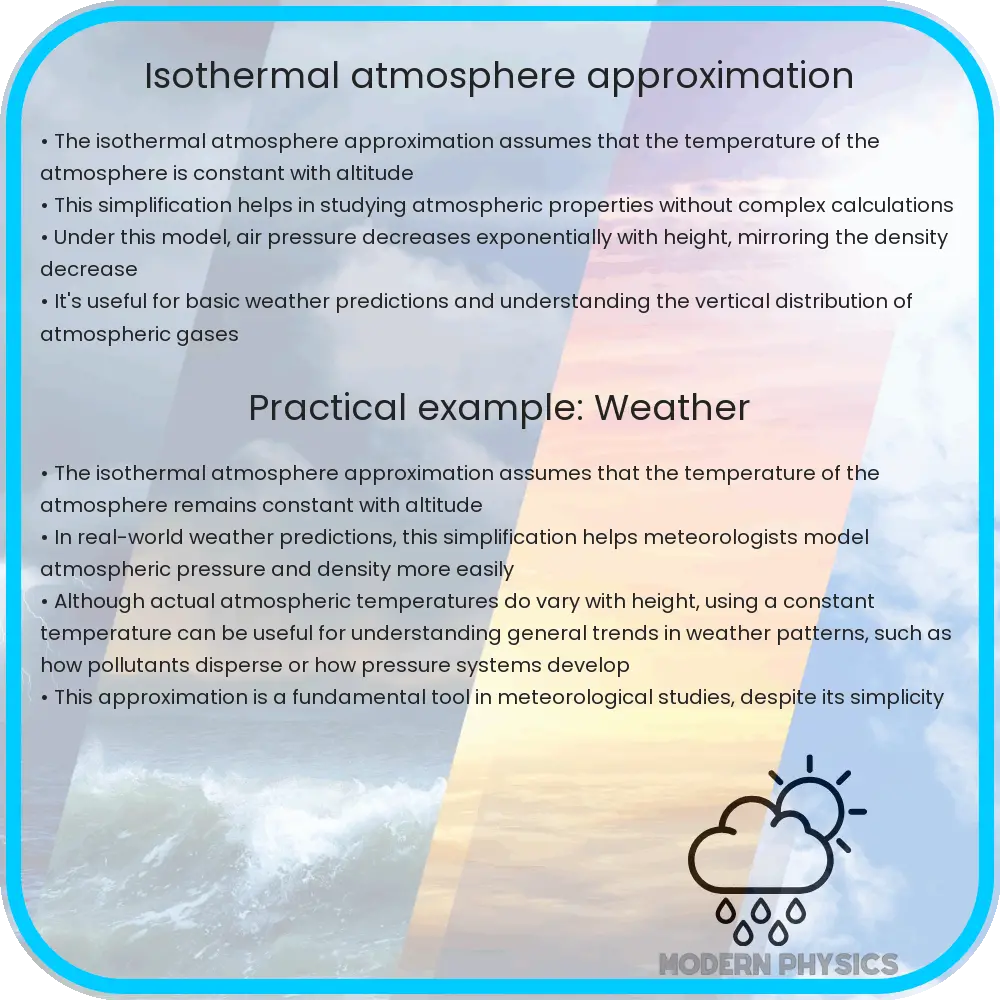Learn about the isothermal atmosphere approximation used to simplify atmospheric physics by assuming constant temperature at all altitudes.

Understanding the Isothermal Atmosphere Approximation
The concept of an isothermal atmosphere simplifies the complex nature of atmospheric physics by assuming that the temperature throughout the atmosphere remains constant with altitude. This approximation is beneficial for understanding specific atmospheric behaviors and for simplifying mathematical models. In this article, we will explore the stability, modeling, and dynamics related to the isothermal atmosphere approximation.
What is an Isothermal Atmosphere?
An isothermal atmosphere is a theoretical concept where the temperature is considered constant at all elevations above the Earth’s surface. In reality, atmospheric temperature typically decreases with altitude in the troposphere, but considering it constant allows physicists and engineers to model atmospheric properties using simpler equations.
In the isothermal model, the pressure and density of the atmosphere decrease exponentially with altitude. This relationship can be derived from the ideal gas law combined with the hydrostatic equilibrium condition, which states that the upward force due to pressure gradient equals the downward gravitational force.
Mathematical Representation
The key equations governing the isothermal atmosphere are derived from the ideal gas law, \( PV = nRT \), and the equation of hydrostatic equilibrium given by:
- \( \frac{dP}{dz} = -\rho g \)
Here, \( P \) is the atmospheric pressure, \( V \) is the volume, \( n \) is the number of moles of gas, \( R \) is the universal gas constant, \( T \) is the absolute temperature, \( \rho \) is the air density, \( g \) is the acceleration due to gravity, and \( z \) is the altitude.
Assuming the temperature \( T \) is constant, integration of the hydrostatic equilibrium equation alongside the ideal gas law leads to the equation:
\( P(z) = P_0 e^{-\frac{z}{H}} \)
where \( P_0 \) is the pressure at sea level, and \( H \) is the scale height, defined as:
\( H = \frac{RT}{Mg} \)
with \( M \) representing the molar mass of air.
Application in Atmospheric Modeling
The simplicity of the isothermal approximation makes it particularly useful in high-altitude atmospheric studies where the temperature variations are less pronounced than at lower levels. Meteorologists and aerospace engineers often use this model to predict the behavior of pollutants, the propagation of radio waves, and the dynamics of weather balloons at high altitudes.
Furthermore, the exponential decrease of pressure and density with altitude as per the isothermal model provides a baseline for understanding and comparing more complex atmospheric models. It helps in simplifying the general circulation models (GCMs) of Earth’s atmosphere by providing an easily understood reference state.
Stability Analysis in the Isothermal Atmosphere
The stability of an atmosphere can generally be assessed by looking at how disturbances (like small vertical air movements) within the atmosphere grow or decay over time. In an isothermal atmosphere, the stability depends largely on the buoyancy forces acting on an air parcel. If an air parcel is displaced upwards, its pressure adapts to the surrounding pressure but maintains its initial temperature, due to the assumption of constant temperature throughout the layer.
If the background atmosphere’s temperature is constant and matches the parcel’s temperature, the parcel experiences neither a buoyant force upward nor downward. This equilibrium condition is known as neutral stability, which predominates in an isothermal atmosphere. This type of study is crucial for understanding the mixing processes in the atmosphere and predicting the spread of airborne particles or pollutants.
Limitations of the Isothermal Atmosphere Model
While the isothermal atmosphere model provides a simplified way to understand atmospheric dynamics, it has notable limitations. The primary limitation is its assumption of a constant temperature, which is rarely true in the real atmosphere. Temperature gradients, both vertically and horizontally, are common and play a critical role in weather patterns and atmospheric processes.
Moreover, the isothermal model does not account for humidity, solar radiation, wind patterns, and other environmental factors that can significantly affect atmospheric behavior. This limitation can lead to inaccuracies when the model is applied to predict real-world phenomena, particularly in regions where temperature and humidity levels vary extensively.
The Value of Isothermal Atmosphere in Educational Contexts
The isothermal atmosphere model, despite its simplicity and limitations, serves as an excellent educational tool. It allows students and novice scientists to grasp fundamental atmospheric principles without the complexities introduced by varying temperatures and additional atmospheric factors. By mastering this model, learners can develop a strong foundational understanding, making it easier to tackle more complex models and real-world atmospheric conditions later.
Conclusion
The concept of an isothermal atmosphere serves as a fundamental tool in atmospheric science, particularly useful for its simplification of the relationships between altitude, pressure, and density. By assuming a constant temperature, the model allows for straightforward mathematical modeling and aids in understanding basic atmospheric behaviors.
Although it is not a perfect representation of the Earth’s atmosphere, the isothermal model plays a crucial role in educational settings and initial scientific investigations, where complexity can be a barrier to understanding. As students and professionals in meteorology and aerospace engineering venture deeper into their fields, the isothermal model often acts as a stepping stone, paving the way for engagement with more sophisticated atmospheric models that account for a myriad of interacting variables.
In conclusion, while the isothermal atmosphere approximation may not fully describe the dynamic, multivariable system that is our atmosphere, it provides an invaluable framework for learning and initial research, offering insights into the fundamental principles governing atmospheric science.
